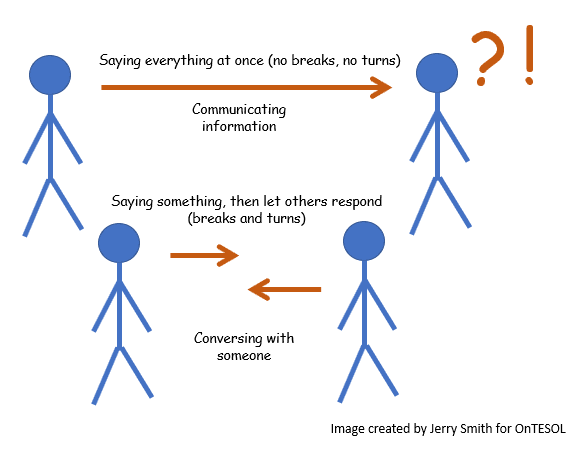Recently, we posted a blog on communicative competence for our students. This time we are going to take how teaching ESL learners take turns in conversations.
The point was to utilize English language training to equip them for interactions in their target language environments.
One of the areas of competence was sociolinguistic competence.
This means using English in a socially acceptable manner.
That could be anything from avoiding taboo topics to using appropriate word choices for particular situations, using polite language, and even allowing others to speak.
In today’s blog, we’ll focus on that last part—how we can teach learners to take turns in conversations.
The Art of Conversations
An example from my own classes over the years is teaching learners not to share everything at one time.
This is when English language learners giving out all the information they possess in one shot. Learners who do this don’t take turns while speaking, as in natural conversations.
It also means that the person on the other end is forced to listen to it all. Then, that same person has to make sense of everything they just heard.
I call it digesting the information they received. If it’s not yet clear, here’s an example. Let’s say, a learner is a real-world tax accountant in the U.S. And he needs to speak with an I.R.S. officer regarding a client’s business tax returns.
He calls the I.R.S., the agent says hello, and from there, the accountant (the learner) unloads everything in one shot.
For example, he says, “Hello, I’m an accountant with ___, and I have a client that needs ___, and we need to find out ___. Then, we have to request an ____, and if we have problems with ___, what do we do?” Imagine being the agent hit with all that—wow! Well, you get the idea, right?
The student had the structure down, the vocabulary, and perhaps even the pronunciation; was capable in discourse competence but failed to be sociolinguistically competent. He wasn’t considering the person on the other end.
Maybe he was nervous and panicked saying everything on his mind to be done with it. The bottom line is he didn’t take turns—he only spoke. He didn’t give the other person the courtesy of interaction.
He communicated his thoughts but did not allow for conversation. In traditional conversations, people take turns. One person says, “Hello, ___ speaking.”
Then the other person responds with, “Hello, my name is ___, and I’m from ABC Accounting Firm.” The other person says, “All right, how can I help you?” The accountant says, “I have a question about a business I’m representing.” The agent says, “What is the name of the company…” and on it goes in that fashion.
It seems like something we might read in an ESL dialogue.
But those dialogues do have their places.
Read: Teaching English Conversation: Using Dialogue To Develop Fluency
Turn-Taking Is the Difference Between Communicating and Conversing
Teaching ESL class members to speak in manageable chunks of information will benefit the development of their sociolinguistic competence.
By demonstrating the benefits of taking turns, learners will see that instead of simply giving information, they can engage others in conversations.
It will also help them tremendously in developing their English conversation skills and improve their interactions.
As their teacher, you can explain the benefits of turn-taking. But are at least four points related to it described below.
More Time to Think
First, instead of spilling all the beans at one time, it gives them more time to think of what they want to say next.
After they say one bit, they pause, wait for a response, then say something else. As they do this, they have time to consider what they’ll say next.
Or they can think about how to respond to what they hear from the other side. Either way, it allows them more time to produce the language they need.
Read: Planned Conversation Strategy To Develop ESL Learner Fluency

Gives Others Time to Digest
Secondly, taking turns allows others an opportunity to digest what the speaker is saying, seek clarification, and respond appropriately.
In conversations, there are opportunities to receive information and reply.
Without that dynamic, a conversation can quickly turn into a lecture.
And, I don’t know about our readers, but not too many people I’ve met like to be lectured.
So, when a student learns to give others opportunities to digest bits of information, it will likely be appreciated.
Decrease Intensity
Thirdly, it will help make a tense situation less intense. Many of our learners are already nervous when they have conversations in English.
This may be amplified even more when they do it with native speakers.
By teaching them to take turns, they can help diffuse the tension they have. How? Because they are expressing themselves in smaller, more manageable bites.
They say a little, then the other party says a little. It just keeps things simpler and decreases the intensity of the situation.
Read: Teaching English Conversation Skills: Passing The Ball Activity
Provides a More Natural Manner of Communicating
When learners speak without giving others a chance to respond, it may be perceived as rude. It may come across negatively.
Even worse, they may come across as extremely nervous and cause others to be apprehensive.
When class members learn how to give and receive while speaking, they’ll be able to make a more favorable impression with others.
Taking turns allows everybody to participate, which is what conversations are.
And as I often say, it’s a win-win.
How Does It Work in Class?
You might be thinking turn-taking sounds good, but how do we make it work in the classroom? Whether in conversation classes, grammar classes or even reading classes, we can model this behavior to our students.
If the subtle approach doesn’t work, we can directly address it when it comes up in class. As in the example above with the accountant, we can demonstrate why not taking turns can be problematic in a conversation.
Then we can explain the benefits.
To convey the idea, I sometimes draw sketches on whiteboards like this: Finally, we can create a dialogue or repeat the conversation discussed but more naturally.
Of course, the dialogue will show breaks and responses. There will be a question or statement then an opportunity to respond from the other side.
Teach Conversational English with Gaba Japan!
Parting Thoughts
As teachers reading this may agree, some students just don’t know how to have conversations. To converse is to take turns with someone.
Granted, many of our students may need to be able to convey information to others such as in presentations or speeches.
However, it’s safe to say that even those learners will need to be able to converse about what they presented.
Therefore, taking turns is helpful in pretty much all situations where a student may engage in spoken interactions.
OnTESOL’s courses offer the best ESL lesson planning training in the world!
This will allow them to participate in conversations in a sociolinguistically competent manner. It will allow them to interact more naturally with others and can reduce the intensity associated with their apprehensions in conversing.
What do you think? What creative ways do you use to promote sociolinguistic competence in your class members? Feel free to share your ideas with us here.
Related Articles:
Five Reasons Why The 70-30 Rule Is Useful In ESL Conversation Classes





